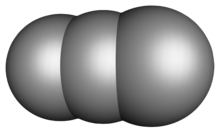This article needs additional citations for verification. (September 2009) |

| |
| Names | |
|---|---|
| IUPAC name
Tricarbon
| |
| Systematic IUPAC name
1λ2,3λ2-propadiene | |
| Other names
Triatomic carbon[citation needed]
| |
| Identifiers | |
3D model (JSmol)
|
|
| ChemSpider | |
PubChem CID
|
|
CompTox Dashboard (EPA)
|
|
| |
| |
| Properties | |
| C3 | |
| Molar mass | 36.033 g·mol−1 |
| Thermochemistry | |
Std molar
entropy (S⦵298) |
237.27 J K−1 mol−1 |
Std enthalpy of
formation (ΔfH⦵298) |
820.06 kJ mol−1 |
| Related compounds | |
Related carbon molecules
|
Diatomic carbon |
Except where otherwise noted, data are given for materials in their standard state (at 25 °C [77 °F], 100 kPa).
| |
Tricarbon (systematically named 1λ2,3λ2-propadiene and catena-tricarbon) is an inorganic compound with the chemical formula C
2(μ-C) (also written [C(μ-C)C] or C
3). It is a colourless gas that only persists in dilution or solution as an adduct. It is one of the simplest unsaturated carbenes. Tricarbon can be found in interstellar space and can be produced in the laboratory by a process called laser ablation.